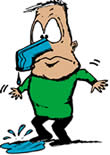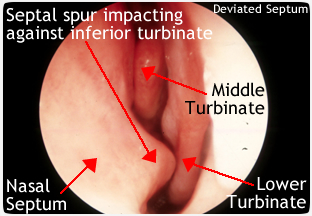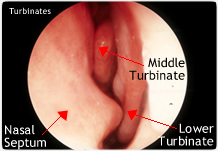You Deserve a Breath of Fresh Air®
Your Choice for Advanced Sinus & Sleep Care
Hillcrest Medical Building Atrium
6770 Mayfield Rd, Suite 425
Cleveland, OH 44124
800-24-SINUS (247-4687)

Sinus and Nasal Disorders
What are the sinuses?
The sinuses are air filled spaces within the face and head. They have connections to the nasal cavity. There are four (4) groups of sinuses on each side of the face--the frontal, ethmoid, maxillary and sphenoid. Normally the sinuses form mucus that drains into the nose while air is entering the sinuses form the nose. No one really knows or understands the functions of the sinus but occasionally the sinuses can be the site of infections.
Page Quick Links
What is Sinusitis and What Can I Do about It?
Sometimes, when you have a sinus infection, you may have one or more of the following symptoms:
- Stuffy Nose
- Headache, Facial Pain, or Pressure
- Cough
- Nasal drip and Drainage
- Bad Breath
- Loss of Sense of Taste and/or Smell
- Fever
- Fatigue
- Ear pressure
- Tooth pain
- Asthma (difficult to control breathing) out of control
What to do:
Try an over-the-counter decongestant (pseudoephedrine) to open the sinuses.
- Use over the counter medications to thin the mucus like saline (salt water) nasal spray and guiafenessin pills (Mucinex™).
- Avoid antihistamines because they may dry and thicken the mucus making it difficult to drain from the sinuses.
- When these nasal and sinus symptoms linger for more than one week, or are worsening after a few days, you may need to see a physician to be treated for an acute sinus infection.
If your symptoms continue even after medical treatment, you may have chronic sinusitis (sinusitis lasting more than 12 weeks). Or if you get better only to have your problems return again and again, you may have recurrent acute sinusitis.
Chronic and recurrent acute sinusitis may require a nasal endoscopic examination and computed tomographic x-ray examination (CT scan) of the sinuses because there are several causes for chronic and recurrent acute sinusitis including abnormal anatomy or nasal polyps.
Runny Nose
 Stuffy, runny noses are common problems. This may be caused by allergic or non-allergic problems.
Stuffy, runny noses are common problems. This may be caused by allergic or non-allergic problems.
But you ask, why does my nose run? There are several reasons...
Allergic rhinitis is caused by dust, ragweed, and pollen. These allergies should be cared for by your allergist. If the nasal drainage is too bothersome, turbinate reduction procedures (Coblation™) may be helpful.
 Vasomotor rhinitis is a non-allergic condition caused by sudden changes in the air you breathe. Smells, temperature, humidity and even eating can cause some people to have a runny nose. Prescription nasal sprays and pills often help. For some turbinate reduction will also help.
Vasomotor rhinitis is a non-allergic condition caused by sudden changes in the air you breathe. Smells, temperature, humidity and even eating can cause some people to have a runny nose. Prescription nasal sprays and pills often help. For some turbinate reduction will also help.
Turbinates are the nasal structures that normally expand and contract and help to warm and humidify the air we breathe. Sometimes the turbinates react to air particles and cause a nasal obstruction or excess nasal mucous. This is what is making your nose run! The short, out-patient turbinate reduction procedure, (Coblation™) may help reduce the drainage.
The RhinAer® device goes straight to the source of the symptoms – the out-of-balance nerves that control nasal congestion and secretions.
Nasal Polyps
Nasal polyps are non-cancerous growths occurring in the nose or sinus. There is no known cause for nasal and sinus polyps although there is evidence that they are the result of inflammation . Nasal polyps often cause a blocked nose making it hard to breathe, decreasing the sense of smell (which then causes a decrease sense of taste and resulting in a thick discolored nasal drainage and sinusitis.
Polyps can also cause a sinus "backup" where normal nasal drainage just can't get out of the sinuses. When normal drainage is stuck in the sinuses, it may become infected-and this is what causes the thick and discolored nasal drainage.
Treatment for nasal polyps usually begins with medical management to reduce the size of the polyps. This typically requires some combination of steroid given by mouth, spray or aerosol. Sometimes medical management requires the use of medications to fight fungus. When nasal polyps are not medically manageable, surgery is usually effective. However, even with the best of operations, some medical management is often needed to minimize the chance of the polyps returning.
Surgery for nasal polyps requires nasal endoscopy and is usually done in an out-patient ambulatory surgery center where patients go home the same day.
Deviated Septum
 Deviated Septum is a common breathing disorder. The wall separating the two sides of the nose is called the septum. The septum may be twisted or deformed-thus the description "deviated"-meaning not straight. This may have occurred from an injury or just the way the septum grew. A deviated septum may cause breathing problems on one side of the nose, but sometimes both sides are affected. The problem of nasal blockage can be a result of the deviated septum.
Deviated Septum is a common breathing disorder. The wall separating the two sides of the nose is called the septum. The septum may be twisted or deformed-thus the description "deviated"-meaning not straight. This may have occurred from an injury or just the way the septum grew. A deviated septum may cause breathing problems on one side of the nose, but sometimes both sides are affected. The problem of nasal blockage can be a result of the deviated septum.
Nasal Turbinates
 What causes my runny nose?
What causes my runny nose?
Whether the cause is allergic rhinitis or vasomotor rhinitis, the problem within the nose is the same. Structures in the nose called Turbinates react to the offending odor or airborne particles by swelling and pouring out mucus-as if the body were trying to block and cleanse the breathing passage.
Turbinates are small shelf-like structures that are always changing in size. There are three or four of them on each side of your nose. We are most familiar with the congestion that occurs within the turbinates when we have a cold or allergies.
For temporary relief we use decongestant nasal sprays and pills. Although many people find this gives excellent relief, long term use of nasal sprays not only makes the problem worse but also using decongestant pills may cause high blood pressure, increase the heart rate, and for some people even cause sleeplessness
Learn about Nasal Turbinate Reduction
Empty Nose Syndrome (ENS)
Empty Nose Syndrome (ENS) is a complex disorder that may be from trauma or by physician over-operating. It occurs when the normal structures in the nose that help warm and humidify the air (turbinates) are removed from the nasal passages. These turbinates project into the nose and usually there are three or four on each side: inferior (lower), middle, and superior (upper) and sometimes even a supreme turbinate (highest). Most often aggressive removal of the lower (inferior) turbinate is the culprit in empty nose syndrome. While one might think removal of these turbinates would result in a more open feeling to breathing, it does not.
A patient's computed tomographic (CT) scan looks empty and missing the normal tissue following nasal surgery, specifically turbinate excision.
What symptoms does a patient with Empty Nose Syndrome (ENS) experience?
Patients with ENS feel as though their nose is always congested and that they cannot get in sufficient air through their nose to breathe adequately. They may report they feel as though they are congested/stuffed/suffocating. Paradoxically, they may report that the only time that they feel as though they are breathing okay is when they are congested and have a cold. Pain may be an issue, though not the main issue. The patient may also complain of crusting in their nose.
Diagnosing ENS
Diagnosing ENS relies upon a patient’s symptoms, along with several physician observations. A history of nasal turbinate surgery is always present. A CT scan or nasal endoscopy will often reveal tissue loss. A cotton test (moist cotton placed into the nasal cavity to selectively limit and redirect the airflow without complete obstruction), or local saline injection into the deficit area will bring an improvement in symptoms and suggests that a more permanent implant may help.
Managing ENS
To rehabilitate ENS patients an implant of a cellular dermis (Alloderm™) can be placed under the lining of the nasal cavity. This implant provides additional resistance for breathing, lessening the sensation of suffocation. Following this nose is typically moister as the air flows through the nasal cavity more slowly. Unfortunately relief of pain has not been very successful with implantation; chronic pain after nasal surgery is better assessed by a pain therapy specialist. The location of the implant is based upon history, exam, CT findings, and the results of a cotton test in the office.
(Results reported for the management of Empty Nose Syndrome in Archives Otolaryngology, September 2007, a medically peer reviewed journal.)
Learn About Howard L. Levine MD
 Howard L. Levine MD is one of the pioneers in the development of advanced nasal endoscopic diagnostic techniques, functional endoscopic sinus surgery and advanced applications of radiofrequency energy for nasal and sinus disease. Listed in The Best Doctors in America and Top Doctors in Cleveland, Dr. Levine is world-renowned as an expert in nasal and sinus disorders. Dr. Levine, is a past national president of the American Rhinologic Society (ARS), the world’s largest organization in nasal and sinus disorders.
Howard L. Levine MD is one of the pioneers in the development of advanced nasal endoscopic diagnostic techniques, functional endoscopic sinus surgery and advanced applications of radiofrequency energy for nasal and sinus disease. Listed in The Best Doctors in America and Top Doctors in Cleveland, Dr. Levine is world-renowned as an expert in nasal and sinus disorders. Dr. Levine, is a past national president of the American Rhinologic Society (ARS), the world’s largest organization in nasal and sinus disorders.
Advanced Treatments
 The cornerstone of Cleveland Nasal Sinus & Sleep Center is our connection to the “latest and greatest” technology that provides to our patients the best outcomes with the least trauma. Howard L. Levine MD is and has been a consultant and primary investigator for several ear, nose and throat medical device companies.
The cornerstone of Cleveland Nasal Sinus & Sleep Center is our connection to the “latest and greatest” technology that provides to our patients the best outcomes with the least trauma. Howard L. Levine MD is and has been a consultant and primary investigator for several ear, nose and throat medical device companies.
Nose News....is Good News®!

Cleveland Nasal Sinus & Sleep Center has a new location!
Hillcrest Medical Building Atrium
6770 Mayfield Road, Suite 425
Cleveland, Ohio 44124.
Telephone: 440-684-9980.
This new facility within the Hillcrest Medical Building Atrium, has adjacent free parking, valet parking, access from a major interstate highway, affordable accessible hotels and motels and nearby shopping centers
Read More...